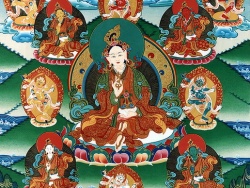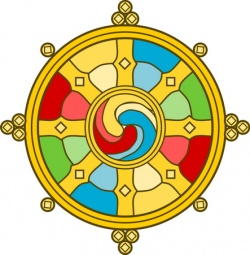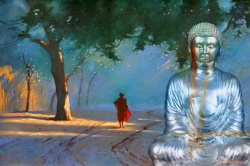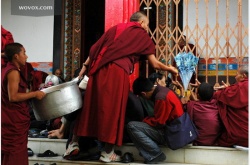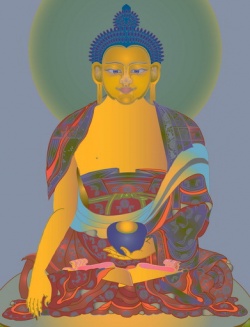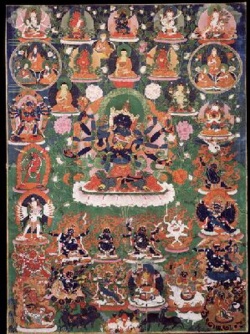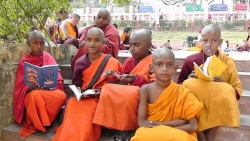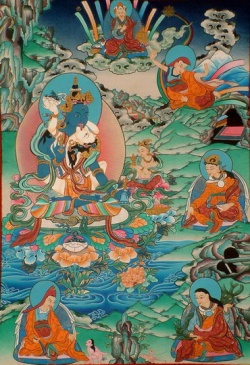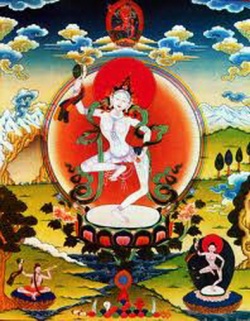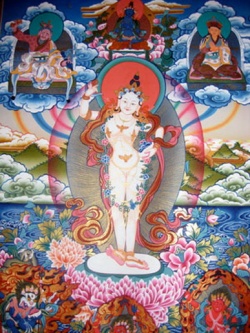Yeshe Tsogyal, Princess Of Karchen
Yeshe Tsogyal (777-837 A.D.) was born in the princely Kharchen family.1
Her father's name was Namkhai Yeshe and her mother was called Ge-wa Bum. When she was born, a spring of fresh water spontaneously burst from the ground and formed a sizable pond next to her house. This pond came to be known as "Lha-tso", the Divine Lake. Later the spot would become a famous pilgrimage site for generations of devotees.
==Sadaprarudita and the Merchant's Daughter==
In ancient Buddhist history it is recorded that, around the beginning of the Christian era, a young spiritual seeker called Sadaprarudita came from the West to northwestern India in quest of knowledge and Enlightenment.
He became a disciple of the very learned Master Dharmodgata of Kashmir. Sadaprarudita received from Master Dharmodgata the sacred treatise that is known as the Golden Book "sealed with seven seals", the root text of Transcendental Wisdom (Prajnaparamita).2
In the records of these long ago events, there is mention of a certain merchant's daughter who helped and encouraged the self-sacrificing Sadaprarudita, and without whom he never would have succeeded in his quest.
That merchant's daughter, along with Sadaprarudita, worked hard on the spiritual Path.
She is recognised as a great Bodhisattva, and to this day is known as Saraswati-devi,3 the divine mother of knowledge, grace and Wisdom. Indeed, Sadaprarudita could not have attained his Enlightenment without her aid.
It is said that Yeshe Tsogyal was an incarnation of the Bodhisattva Saraswati-devi.
A Disciple Of Lord Padmasambhava
Life was not at first good to Yeshe Tsogyal.
She was brutally raped by her first suitor and fought over by her second. When she fled from the latter, she was taken and placed in the Emperor's harem.
Later the Sage-Emperor offered her as a consort to our Master, the Lord Padmasambhava.
Lord Padmasambhava set her free and she became his disciple.
Only then did she begin to discover happiness in her life.
That was in the year 794 A.D., when Yeshe Tsogyal was sixteen years old.
When she received Empowerment her flower fell on the sacred mandala of Vajrakilaya and through practicing the appropriate sadhana she rapidly gained accomplishment.
She then received all of the Lord Padmasambhava's teachings and became his spiritual heir.
Since Yeshe Tsogyal possessed a phenomenal photographic memory, it was possible for her to memorize vast numbers of texts without the slightest difficulty.
Thus the entire Khadro Nying-t'ig teachings were handed into her care.
The Princess Yeshe Tsogyal traveled to Nepal in 795 A.D., where she met her soul-mate and mystical consort, Atsara Sahle.
The Yogini and her consort traveled to various hermit Caves, where they practised their Sadhana with great diligence.
Yeshe Tsogyal would seem to have been a stronger personality than her mate.
She had suffered extensively in her youth. She had great determination to attain spiritual awakening. Atsara Sahle was from the valley of Kathmandu, where the biting cold of Tibet in winter is never experienced.
It was therefore more difficult for him, when they lived as hermits in the high mountains. Yet both struggled as best they were able on the hard path of spiritual endeavour.
There came a period when, while living alone in the wintry cave of Nering Senge, her mate having retreated to warmer climes, that Yeshe Tsogyal began to face all the demons of her mind.
Visions rose up before her in the process of her meditations, equal to those of Buddha Sakyamuni beneath the Bodhi-tree, or Christ in the throes of his Temptation, or St. Anthony in the Desert, full of hideous and terrifying intensity.
Hordes of phantoms advanced upon her: fearful, seductive, malign, and evil.
With these, the product of her own traumatic passions, she wrestled, while remaining unmovable in her vajra-like Samadhi, the immutable poise of impartial contemplation.
For days the onslaught continued, until finally she was left in peace.
This was the trial of her final spiritual catharsis.
Afterwards, at the lonely cave of Paro Taktsang in the highlands of Bhutan, with her consort Atsara Sahle, she disciplined herself through vigorous fasts, long meditation,
and the spiritual practice known as karmamudra, so as to blend the refined positive and negative seed essences (bindus) of her heart nerve-plexus (cakra) and branch nervous-systems (nadi),
from whence the five major and five secondary bio-energies (vayu) of the living Body derive, so as to crystallizing in the whole of her presence the basis of an inner vajra-Body.
This rigorous blending together of refined nerve substance (the white and red seed essences), and the undoing of the last psychological knots of the heart centre, pertains to the final stage for winning Buddhahood in a single lifetime.
Yeshe Tsogyal's retreat at Paro Taktsang would be the last austerity practiced for her own benefit.
In Paro Taktsang after pursuing her goal with incredible diligence, Yeshe Tsogyal attained the level of a world-encompassing Insight holder. Thus she gained the basic stages of Enlightenment.
Later she travelled all over Tibet with her Precious Guru, the Lord Padmasambhava, Blessing particular locations and depositing Treasure texts for the benefit of future mystics.
She went into an isolated Meditation Retreat in 796 and did not come out until 805, after her great Guru had already left Tibet, but when she did finally emerge it was as a fully Enlightened Buddha.
Possibly in 837, but perhaps later, she transcended worldly existence, ascending bodily to the manifest pure field dimension of the Sacred Red Mountain, the luminous sphere of her Guru, the Lord Padmasambhava.
Footnotes
1 An excellent biography in English translation of Yeshe Tsogyal is Sky dancer, the Secret Life and Songs of the Lady Yeshe Tsogyal, by K. Dowman, Snow Lion, NY.
2 Prajnaparamita = Transcendental Wisdom. See Conze, Buddhist Studies, Oxford 1967. Conze draws a remarkable parallel between the Prajanparamita-Sutra and the book of seven seals mentioned in the Revelation of John.
To Sadaprarudita's question, "Where is the book of Transcendental Wisdom?", in the Astasahasrika prajnaparamita-Sutra, Shakra answers:
"It has, son of good family, been placed by the holy Dharmodgata, the Bodhisattva, the great being, in the middle of this pointed tower, after he had written it on golden tablets with melted vaidurya, and sealed it with seven seals."
(Conze's translation). In Revelations we read:
"And I saw lying in the right hand of Him a book written within and without closely sealed with seven seals."
Conze also notes that in so far as the name Sadaprarudita means "ever weeping", so we find in St John (v.4) a reference to Jesus as one who "weeps bitterly".
3 In the lore of ancient India the gracious Saraswati, patron saint of the arts and learning, is considered the female aspect, or soul mate, of Arya Manjusri, the Bodhisattva of Wisdom and science.
There was a river named after her, now called the Sarsuti, which flows from the Himalayas and is lost in the sands of the desert.
In ancient times it flowed on to the sea and bestowed fertility to the neighboring lands.
Just as this river once watered the ancient civilization of India, which arose along its green banks, so it is, said that the Bodhisattva Sarasvati's divine mission is to nurture worldly beings with an Appreciation for artistic Beauty and gentle culture.
She is usually pictured as of a white colour, with graceful but full figure, wearing a slender crescent on her brow and sitting on a lotus.
Other names of Saraswati are Brahmi, Sarada-devi, Putkari, Vagiswari and Devi.
